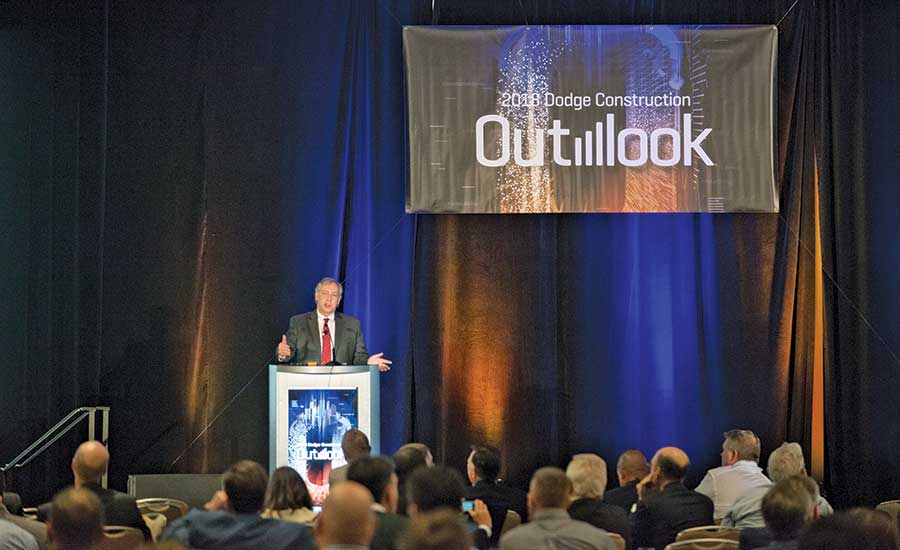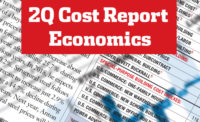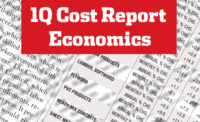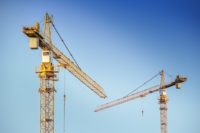A dip in public works combined with a substantial decrease in utility work, weak industrial markets and slower-than-anticipated growth in residential construction all put a damper on general construction growth in 2017. The consensus among economic forecasts analyzed by ENR indicates a very modest rebound in growth in 2018.
Total construction starts soared 13% in 2015, but the growth rate declined to 5% in 2016, according to Dodge Data & Analytics. That rate is estimated to slow to 4% this year and continue to fall to 3%, to $765.2 billion, in 2018, according to Robert Murray, Dodge’s chief economist.
An FMI Corp. forecast calls for next year’s total construction put-in-place to increase 5.2%, to $1.3 trillion, which is an increase from a 4.3% rate in 2017 but still slower than 2016’s growth rate of 6%.
The Portland Cement Association sees a much steeper drop in construction put-in-place, with growth falling to just 1.1% this year from 4.0% last year. PCA forecasts that growth will bounce back to 3.5% in 2018, citing $1.06 trillion in new work.
The American Road & Transportation Builders Association estimates that total spending for highway construction will fall from $60.5 billion last year to $56.7 billion in 2017, while bridge work will decline to $30.5 billion from $33.3 billion over the same period. ARTBA’s forecast calls for both markets to post a modest rebound next year, with $57.8 billion in new highway work and $31.1 billion in new bridges.
The National Association of Home Builders predicts that residential construction will continue to grow but at a slower-than-anticipated rate. It expects single-family housing starts to reach 903,000 in 2018, increasing from an estimated 840,000 this year. However, NAHB says the slowdown in multifamily housing will continue over the next two years. That market fell to an estimated 356,000 in 2017 from 393,000 starts last year. NAHB predicts that number will fall to 350,000 next year and decline to 338,000 by 2019.
Growth To Remain Modest in 2018 Full PDF
Single-Family Market Rising
“The U.S. construction industry has moved into a mature stage of expansion,” says Murray. “After rising 11% to 13% per year from 2012 through 2015, total construction starts advanced a more subdued 5% in 2016.”
Single-family housing starts are expected to see the sharpest increase next year, according to Dodge. Murray attributes a predicted 9% boost, to $219.8 billion, to older millennials entering the housing market. Murray refers to mortgage rates, when tied to the continued growth of the single-family housing market, as “the biggest wild card” but adds that rates are currently low and expected to grow slowly enough not to greatly impact the housing market in 2018. However, in the multifamily housing sector, an 8% drop in starts is expected. The market will see a decrease for the second year in a row, following an all-time high of $95.2 billion in 2016. Murray attributes the downward trend to demographic shifts as well as changes in bank lending regulations.
“As the single-family housing market more fully recovers from its hangover, the allure of multifamily housing is fading,” Murray says. “The third-quarter vacancy rate (in multifamily units) was 4.6%—10 basis points higher than a year earlier—after the second quarter had risen 20 basis points from its year-earlier level.”
In the commercial sector, 2% growth is expected, marking a second year of modest increase following a 21% spike in 2016. While starts are expected to increase 1% in 2018, retail construction has slowed, falling 10%, to $18.4 billion, in 2017. This drop is partially due to the rise in online shopping; for example, in the second quarter of 2017, e-commerce sales reached a seasonally adjusted $111.5 billion, representing a 16% increased from that time last year. The boost in that sector has also caused an increase in demand for warehouse construction, which Dodge estimates will see 9% growth in 2017, followed by a 4% boost in 2018.
Institutional building experienced a 14% boost in 2017, mainly due to large transportation terminal construction, which experienced a massive 120% increase, to $20.6 billion. The surge resulted from billion-dollar projects breaking ground at airports in New York, Los Angeles and Orlando, among others. In 2018, institutional growth is expected to slow to 3%, with educational facilities seeing an uptick of 11%, to $60.3 billion. Murray also cites “gains for schools and health-care facilities” as a cause for growth.
Manufacturing-plant construction declined in 2015 and 2016, after surging in 2014 due to construction of energy plants. Stable oil prices and an improving export environment allowed for a strong rebound in 2017, as petrochemical plants provided a 27% jump. Manufacturing construction is expected to decline 1%, to $25.1 billion, in 2018.
Public works grew only 1% in 2017, and Dodge estimates that the sector will see a slight bump, to 3%, in 2018. Reconstruction efforts following hurricanes Harvey and Irma will account for part of the increase. Murray notes, “The specifics of a $1-trillion infrastructure program by the Trump administration have yet to materialize, so activity continues to hover around, basically, the plateau for construction starts reached a couple of years ago.” In the event a Trump infrastructure program passes in late 2017 or 2018, “the impact on construction starts would show up more at the end of 2018 and 2019, given the lag in terms of providing funding and getting projects to reach the construction start stage,” he observes.
The electric-utility and gas-plant sector is expected to drop 31% in 2017, followed by a 13% drop, to $28 billion, in 2018, according to Dodge. Starts have fallen for the third year in a row after a staggering 128% boost took the total to $57.4 billion in 2015. The Trump administration has rolled back Obama-era regulations for coal-fired power plants and plans to roll back the Clean Power Plan, which calls for cutting greenhouse-gas emissions by 32% from 2005 levels by 2030, but Murray does not expect much of a boost in that department. “With the relatively low cost of natural gas, it’s not likely to be economically feasible to go ahead with new coal-fired plants,” he says.
While the continuing slowdown of growth suggests the construction industry may be reaching a cyclical peak, Murray says, “In the current environment, there are still positive factors that suggest that the construction expansion has room to proceed in 2018.” The outcome will be largely determined by economic and legislative events that take place over the upcoming year, he adds.
Keeping an Eye on Public Works
FMI Corp. also expects a decline in total construction put-in-place growth, estimating the rate will fall to 6% this year from 11% last year. “This slowdown is expected to continue into 2018, with the dollar value of total construction put-in-place increasing just 4%,” says Brian Strawberry, senior economist for FMI.
“We are going to fall far short of the trillion-dollar increase in infrastructure spending that Trump promised on the campaign trail.”
– Ed Sullivan, Chief Economist, Portland Cement Association
“There are risks to virtually all markets in 2018, but the ones we are most cautious about is public works,” Strawberry says. FMI predicts across-the-board declines for all public-works markets, adding up to an overall 4% drop. These declines will be led by 11% for sewage disposal work and 8% for water-supply construction. Likewise, FMI is forecasting a 3% decrease in power-plant work, while the highway market is expected to slip 1%. “States are looking for ways to increase revenue, especially with passing bonds becoming more of an issue,” says Strawberry. “We thought that infrastructure spending would have taken off under President Trump, but that has not happened yet.”
FMI also forecasts several soft markets in the non-residential building sector as annual growth for those markets slows to 6% this year from 11% in 2016, with a predicted 2% gain in 2018. Strawberry expects declines next year of 7% for manufacturing and 2% for the educational building markets. These declines will take some of the steam out of the office building market, which is predicted to climb 9% in 2018, following this year’s robust 21% gain.
Commercial building construction is also expected to continue growing, with a 10% increase in 2018 after rising an estimated 16% this year, according to FMI’s forecast.
Overall Market Growth Slows
“We expect construction growth to slow to 1.1% this year, after rising 4% last year,” says Ed Sullivan, chief economist for the Portland Cement Association. “There are positives, but these are being offset by major disruptions.”
The “major disruptions” have been double-digit declines of 13.3% for conservation, 18.2% for water, 15.4% for sewer and 13.2% for industrial construction. “I was surprised by the large declines in water and sewer systems,” says Sullivan.
Although smaller in percentage terms, the 5.1% decline in the larger highway-and-street market may be even more significant, he notes. “In addition, housing grew some—but, at 3.6%, it’s lagging behind expectations,” he says. That market was dampened by a 4.9% decline in multifamily work.
Sullivan is not looking for a quick turnaround in 2018. PCA’s forecast calls for the growth in highway and water-system construction to flatten out at an annual rate of 0.4% and 0.7%, respectively, before seeing growth improve to 3.4% and 7.5% in 2019. Housing should see a bit of a bounce next year as the decline in multifamily work stalls at -0.2%. Overall, PCA predicts the total residential market will increase 6.3% in 2018. (PCA forecasts construction put-in-place in real dollars adjusted for inflation.) Sullivan says the PCA forecast was reeled back 0.3% because of the hurricanes in Florida and Texas this past summer. “That’s pretty big for two events,” he adds.
Public works are getting hammered by a shortfall in state and local funding. “State expenses, especially pension costs, are increasing faster than revenue, forcing states to cut back,” says Sullivan. While federal infrastructure funding has held steady, it is not increasing at the expected rate. “We are going to fall far short of the trillion-dollar increase in infrastructure spending that Trump promised on the campaign trail,” says Sullivan. “It will probably be about one-quarter of that.”
“Looking at our forecast going out, we see the industry flirting with labor shortages,” says Sullivan. “I wonder if even a modest increase in construction activity can be sustained on the [labor] supply side,” he concludes.
Downturn for Highways and Bridges
ARTBA confirms the slowdown in growth for highway and bridge work, also citing funding problems at the state and local level.
“Twenty-six states have increased gasoline taxes, but that has not translated into higher growth,” says Alison Black, chief economist for ARTBA. “The ups and downs among the states washes out on the national level.”
Black points to the winding down of two major bridge projects—the Tappan Zee replacement bridge in New York City and the Louisville-Southern Indiana Ohio River bridge—as putting a drag on the bridge market. ARTBA predicts there will be $31.1 billion worth of new bridge construction in 2018, a slight increase from this year. “For example, New York still has a $1-billion bridge market, but it used to be $3 billion,” Black points out.







Post a comment to this article
Report Abusive Comment